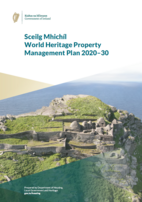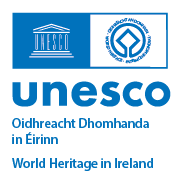New Ten-year Sceilg Mhichíl Management Plan strengthens commitment to protect, conserve and promote the UNESCO World Heritage Island
Posted on 17 décembre 2021

Minister of State with Responsibility for Heritage and Electoral Reform, Malcom Noonan TD, and the Minister of State with Responsibility for the Office of Public Works, Patrick O’Donovan TD, have today launched a new 10-year management plan for the UNESCO World Heritage Property of Sceilg Mhichíl.
This second ten-year management plan is an important milestone in the story of Sceilg Mhichíl, which began when monks first colonised the island off the County Kerry coast, perhaps as early as the sixth century. The island is an iconic site, as recognised in its 1996 UNESCO inscription.
The plan reaffirms the shared mission of the Department of Housing, Local Government and Heritage and the Office of Public Works to protect, conserve and promote an appreciation of the early monastic site and its island setting by having in place a management framework to ensure that it is preserved for present and future generations. It balances the challenges of managing sustainable visitor numbers to the very popular location with protection of the island’s fragile cultural and natural heritage.
The overall management framework detailed in the new Management Plan to protect the Outstanding Universal Value of Sceilg Mhichíl is framed around specific objectives and 90+ actions, including:
Preservation of Sceilig’s Mhicíl’s heritage. Publication of all conservation and archaeological works undertaken on the island as well as a conservation-led approach to enhancement and restoration of the former lighthouse buildings.
Natural heritage conservation. Continuation of the seabird-monitoring programme, with particular attention to burrow-nesting seabirds. On an annual basis, a census will be carried out of cliff-nesting seabird species.
Monitoring the impacts of climate change. A framework for monitoring climate change on the island will be created, for example by monitoring changes such as erosion, major weather events and through ecological surveys, as well as carrying out a Climate Vulnerability Assessment.
Sustainable management of tourism and visits to Sceilg Mhichíl. Maintenance of a strictly defined annual season (at present mid-May to end of September). Visitor impacts will be monitored and numbers will be reviewed annually with particular attention to the sustainability of the 180 visitors per day limit. The plan also commits to preventing unauthorised drone and helicopter flights.
Outreach and research. Creation of an education outreach programme within the context of facilities being contemplated at the Skellig Experience plan’s Visitor Centre in Portmagee, linking to schools and other educational institutions. An overall research framework will be established to support ongoing research and encourage research among third level institutions.
Local engagement and stakeholder dialogue. Establishment of a Sceilg Mhichíl stakeholder forum to support the ongoing management of the site and ensure dialogue with key stakeholders. The plan supports local initiatives in the broader region and the Iveragh Peninsula, such as organised tours of areas of historical or biodiversity interest.
Minister Noonan said:
« This new management plan establishes firm commitments to protect and conserve one our nation’s most precious sites for archaeological, natural and built heritage, while sustainably managing access to a very popular location at the heart of the heritage tourism offering of Ireland, and Kerry in particular.
I am extremely proud of the work of our National Monuments Service and National Parks and Wildlife Service in protecting this extraordinary island through the ongoing partnership with the Office of Public Works.
This management plan will also mitigate the effects of climate change, which presents an increasing threat. We have already seen the impacts of extreme weather, such as increased rockfalls. Our joint efforts to protect this national treasure are all the more important in that context. »
Minister O’Donovan said:
« Sceilg Mhichíl is perhaps our most challenging national monument in terms of maintenance and visitor access. The dedicated OPW workforce of architects, masons and guides, working alongside colleagues from the Department, carry out incredible work, year in, year out, to ensure safe access to the island for the many whose dream it is to visit this spectacular place, while also safeguarding its future. »
Minister O’Donovan added:
« As we look to the next ten years, we will focus on bringing back to life the two beautiful nineteenth-century lighthouse complexes, in order to shine a light on that fascinating maritime heritage and the lives of the keepers and their families who left their own mark on the island many centuries after the monks. »
The Management Plan is available for download at the GOV.IE site and here.
Notes:
Inscribed on the UNESCO World Heritage List in 1996, Sceilg Mhichíl is one of three World Heritage Properties on the island of Ireland, alongside Brú na Bóinne and the Giant’s Causeway.
In its UNESCO inscription affirming its Outstanding Universal Value, it is noted that the monastic enclosure of Sceilg Mhichíl illustrates, as no other property can, the extremes of a Christian monasticism characterizing much of North Africa, the Near East, and Europe. It is an outstanding, and in many respects a unique, example of an early religious settlement deliberately sited on a pyramidal rock in the ocean, preserved because of a remarkable environment.
Sceilg Mhichíl is the most spectacularly situated of all the early medieval island monastic sites in Ireland, with well preserved access steps, a monastery, a remote hermitage and other monastic structures. The island’s isolation has helped to preserve and protect these monastic remains. Their state of preservation and authenticity mean that Sceilg Mhichíl is of immeasurable historical importance. It represents a unique cultural achievement, illustrating a significant period of history and a civilisation that disappeared long ago.
In addition, the island embodies the establishment of lighthouses on Ireland’s coast in the 1820s – a project that was particularly challenging along the Atlantic seaboard. This engineering achievement was quite remarkable for its time. Two lighthouses were established and linked by a remarkable road cut into the rock along the southern edge of the island. Beginning at the Upper Lighthouse, the road passes the Lower Lighthouse and leads to the pier at the eastern extremity of the island. This pier is the main landing place for modern-day visitors.
Sceilg Mhichíl is also one of Ireland’s most important sites for breeding seabirds, both for the diversity of the species and the size of the colonies it supports.
